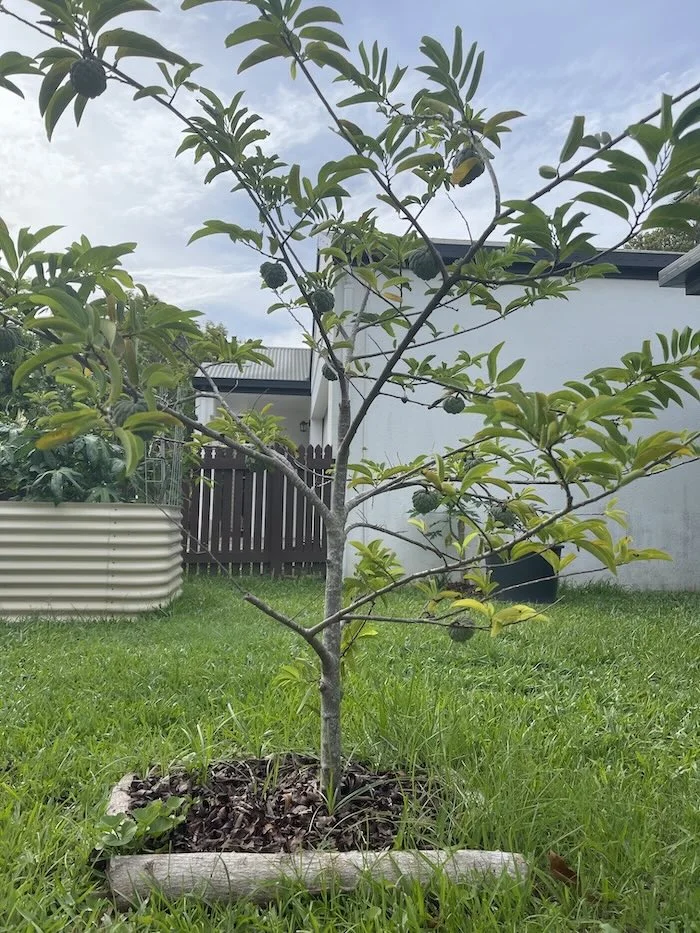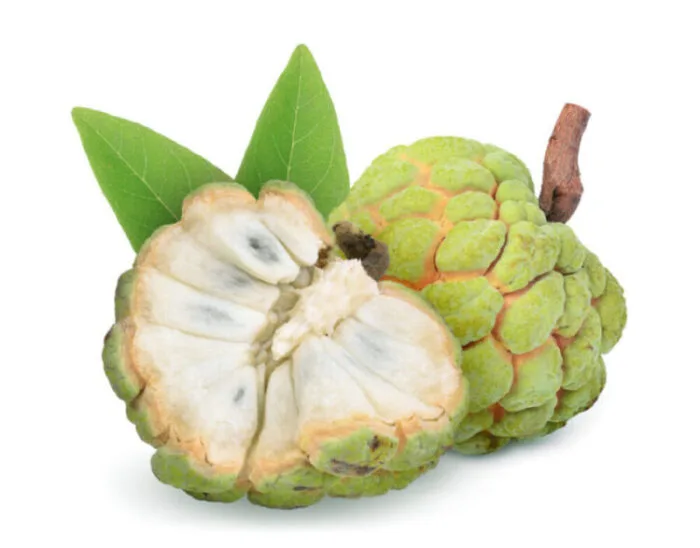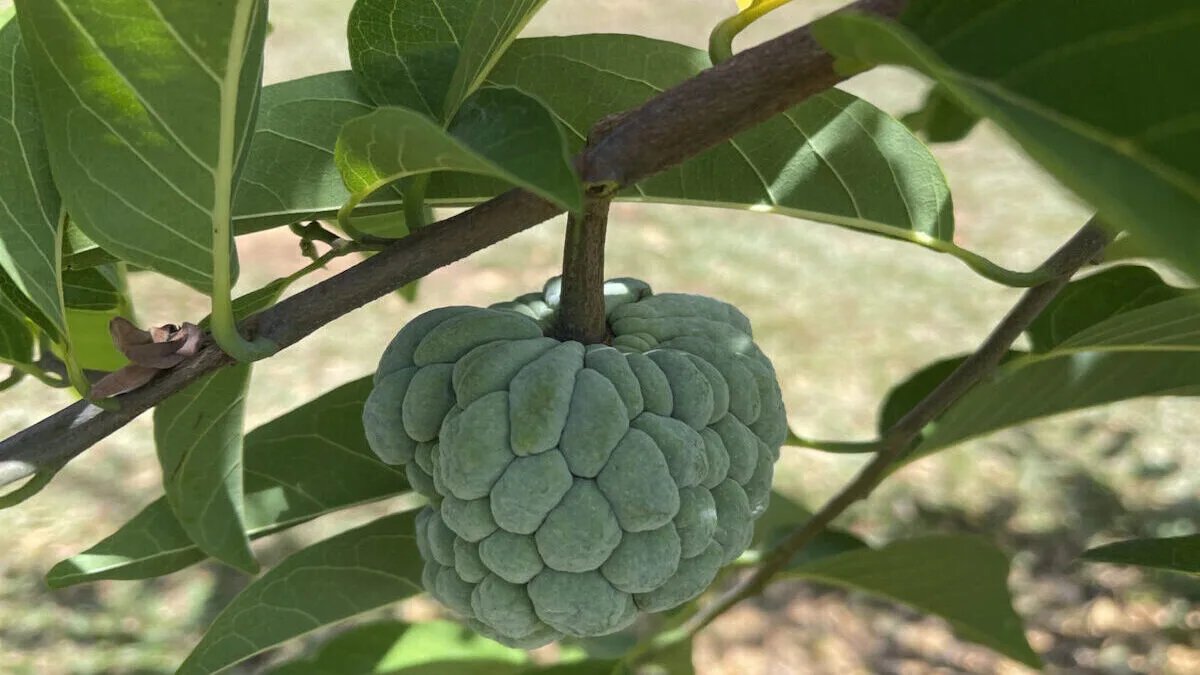Table of contents
Custard Apple Tree Australia
Custard apple tree care should ensure you continue to receive this creamy sweet tasting tropical fruit, that is also known as the sugar apple.
This plant originated in the Americas, but has been found in Timor as early as 1000 CE. However, while native to South America, this luscious and flavoursome fruit today has Australia as its largest commercial producer.
This tree is grown along the sub-tropical and tropical coast of the eastern seaboard, from the Atherton Tablelands in North Queensland to Lismore in Northern NSW.
Custard Apple Tree Varieties
There are two main varieties of custard apples. These are the Pinks Mammoth (or Hillary White) and the African Pride. These are both sweet, juicy and delicious. Other commercially available trees are:
- Geffner
- Golden Emperor
- Maroochydore Gold
- Tropic Sun
We have found a dwarf Tropic Sun to be perfect for our tropical home garden.
Custard Apple Tree Height
The custard apple tree can grow from 3 meters (9.8 ft) to 8 meters (26 ft) tall.
Another option is to grow a dwarf tree. These are perfect for the residential gardener with limited space. These trees grow to about 2.m tall (6.5ft).
Custard Apple Tree Photos

Custard Apple Tree from Seed
Time needed: 3 minutes
How to grow a Custard Apple Tree from Seed.
- Collect seeds.
Scoop out the seeds from a ripe custard apple fruit. Rinse seeds to remove some of the pulp.
- Soak and dry seeds.
Soak the seeds in water for a day or two. Throw out those that float and remove the others and place them on newspaper or a paper towel to dry out. After drying for a week they are ready for planting.
- Plant seeds.
Plant seeds 2 or 3 cm (1 inch) deep in a container of potting mix. Water and then leave in direct sunlight.
- Germination.
The seeds will germinate in 3 weeks or so. When your plant becomes too big for the container, plant it out into the place it will live out its life.
- Patience.
Trees grown from seed should crop in 4 to 6 years.
Most custard apple trees are grown from grafting. While you can easily grow them from seed, grafted trees ensure fruit quality. It ensures the taste, amount of seeds and size of the fruits. Grafted trees also fruit sooner than those grown from seed.
Custard Apple Tree Information
The following information is useful in growing healthy custard apple trees.
Location and Soil
This tree thrives in the tropics as an evergreen perennial. It can be grown in the sub-tropics as well, but in colder regions it will become deciduous.
When growing, go for well-draining soil that is sandy and loamy. A mixture of sand and garden soil is best. This plant is forgiving of poor soil, but areas that become waterlogged should be avoided.
Fertilising
Apply a citrus fertiliser every three months until the tree begins to bear fruit. Feeding potash is done to increase flowering.
Regular fertilising of mature trees is not common, but when done it is known to increase longevity and slow the decline of trees.
Pruning
Pruning your custard apple tree serves a number of purposes. It can help to restore the centre of gravity to a tree that is leaning (you can also stake young trees to help with this).
Pruning can also keep your tree a manageable size for an urban environment and make fruit production more prolific. It can also make it easier for you to harvest the fruit, by keeping them at a height you can reach.
Growing in a pot
Start off in a 35 litre (10 gallon) container and upgrade to a 90 litre (24 gallon) container when growth requires repotting. Also remember to make sure the top of the root ball is level with the top of the pot.
Make sure your container drains well and place it in a sunny spot.
Watering
Water trees regularly throughout the dry season. However, during the ‘wet’ they will be fine without any additional water.
Custard Apple Tree Pests and Diseases
Custard apple tree care means staying on top of pests and diseases. So the pests of this tree include aphids, borer, scales, mealy bugs, and whiteflies.
However, regular application of ‘white oil’ can help address some of these pests. Indeed white oil is an effective organic pesticide that you can make at home.
Custard Apple Tree Fruit
Trees produce a creamy sweet tasting tropical fruit. It also makes for a nutritious snack.
It has a creamy white coloured flesh surrounding blackish or dark brown seeds. The fruit size is generally proportional to the number of seeds within.
To make the fruit ripen faster, put the fruit into a brown paper bag with a banana. As a result, the banana will hasten the ripening of the custard apple.

Health Benefits
The fruit of the custard apple tree is extremely healthy. Indeed some have even labelled it the super-fruit of the 21st century.
Weight Loss
Firstly, consuming this fruit can help with weight loss. Furthermore it has zero cholesterol and studies show it helps to regulate blood glucose levels.
Fibre
Furthermore, the fruit has fibre that adds bulk to stools and helps them move through your intestines. Consequently, when combined with the good bacteria in the fruit, eating custard apples will assist your gut health.
Immune System
Custard apples are also high in vitamin C. So they provide a handy boost to your immune system.
Antioxidants
Bullatacin and asimicin are two antioxidant compounds in the custard apple that are known to have anti-cancer properties.
Prebiotics
A prebiotic is also a ‘a non-digestible’ food ingredient that positively affects a person by stimulating the growth of one or more bacteria (that positively increases health) in the colon.
Finally, thank you for reading and all the best with your custard apple tree care.
Custard Apple Tree for Sale
Custard apple trees can often be found in nurseries across Australia, particularly in tropical and subtropical regions. Specialty nurseries like Daleys Fruit Tree Nursery offer a variety of custard apple trees, including popular types like African Pride and Pink’s Mammoth, which are suited to warm climates.
Many suppliers provide delivery options for online purchases. Local garden centres may also carry these trees, especially in Queensland and northern New South Wales.
Custard Apple Tree Bunnings
These trees can often be purchased from Bunnings, either in a small pot from the nursery section or in seed form. However, why not consider supporting a local nursery? They often have what you need and a lot more besides. Also, often local nurseries sell products suited to the local climate.
Other Tropical Fruits
- Black Sapote
- Dragon Fruit
- Grumichama Tree
- Guava Tree
- Jaboticaba
- Kumquat
- Mamey Sapote Tree
- Mulberries
- Natal Plum
- Passion Fruit
- Paw Paw
- Rambutan
- Star Apple
- Watermelon


Comments
4 responses to “Custard Apple Tree Care”
[…] Custard Apple […]
[…] Custard Apple […]
[…] Custard Apple […]
[…] Custard Apple […]